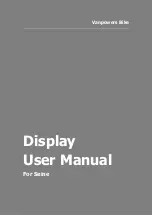
Issue: 01.07.2020
Page 14
Installation
Evacuation & Charging
Once pressure testing has been completed, the system can now be evacuated to remove air and any moisture from the piping.
This can be done as follows:
•
Ensure any nitrogen charge is safely released from the system (including the condensing unit).
•
Connect a gauge manifold to the schrader connections on the service valves on the condensing unit.
•
Connect a vacuum pump and vacuum gauge to the system.
•
Evacuate the system until vacuum is below 250 microns (0.25 torr).
Note: A triple evacuation procedure is recommended for all new systems or where moisture is suspected.
Once the system is isolated and the vacuum pump is switched off, any rise in pressure indicates that either there may be a leak in
the system or moisture is still present. In this case, recheck the system for leaks, repair as necessary, and then restart the
evacuation procedure. Once completed satisfactorily, the vacuum pump and vacuum gauge can be removed.
At this point, refrigerant charge can be added to the system as required. Refrigerant must be charged in the liquid phase into the
liquid receiver/liquid line. Do not charge liquid refrigerant into the suction side of the system.
Important Note:
Moisture prevents proper functioning of the compressor and the refrigeration system. Ensure
that a good quality vacuum pump is used to pull a minimum vacuum of 250 microns (0.25
torr).
Summary of Contents for BSCU-30-M1
Page 1: ...CELLAR PLUS CELLAR COOLER RANGE ISSUE 01 07 2020 CELLAR COOLER RANGE TECHNICAL MANUAL ...
Page 8: ...Issue 01 07 2020 Page 8 Installation Quick Guide Piping Single System Twin System ...
Page 24: ...Issue 01 07 2020 Page 24 Drawings Dimensional drawings Indoor Unit 80E ...
Page 26: ...Issue 01 07 2020 Page 26 Drawings Dimensional drawings Outdoor Units BSCU 40 M1 M3 ...
Page 33: ...Issue 01 07 2020 Page 33 Certification ...
Page 34: ...Issue 01 07 2020 Page 34 THIS PAGE IS LEFT BLANK INTENTIONALLY ...















































